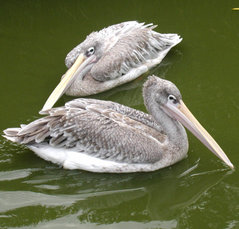Pelican
A pelican is any of several very large water birds with a distinctive pouch under the beak belonging to the bird family Pelecanidae. Along with the darters, cormorants, gannets, boobies, frigatebirds, and tropicbirds, they make up the order Pelecaniformes. more...
Like other birds in that group, pelicans have all four toes webbed (they are totipalmate).
Pelicans use two different ways to feed:
- Group fishing, used by white pelicans all over the world. They will form a line to chase schools of small fish into shallow water, and then simply scoop them up. Large fish are caught with the bill-tip, then tossed up in the air to be caught and slid into the gullet head first.
- Plunge-diving, used almost exclusively by the American Brown Pelican, but only rarely by white pelicans like the Peruvian Pelican of the western South American coast, or the Australian Pelican.
Pelicans can grow to a wingspan of three meters and weigh 13 kilograms, males being a little larger than females and having a longer bill.
From the fossil record, it is known that pelicans have been around for over 40 million years. Modern pelicans are found on all continents except Antarctica: they are birds of inland and coastal waters and are absent from polar regions, the deep ocean, oceanic islands, and inland South America.
Pelicans are gregarious and nest colonially, the male bringing the material, the female heaping it up to form a simple structure. Pairs are monogamous for a single season but the pair bond extends only to the nesting area; away from the nest mates are independent.
Symbolism
Because of its large beak and pouch, the pelican has a particular place in the public imagination: as one poet wrote, "A wonderful bird is the pelican; his beak can hold more than his belly can..." (The verse is attributed both to Ogden Nash and to Dixon Lanier Merritt.)
In medieval Europe, the pelican was thought to be particularly attentive to her young, to the point of providing her own blood when no other food was available. As a result the pelican became a symbol in bestiaries for self-sacrifice, and was used as a symbol in heraldry ("a pelican in her piety").
Species
Read more at Wikipedia.org




